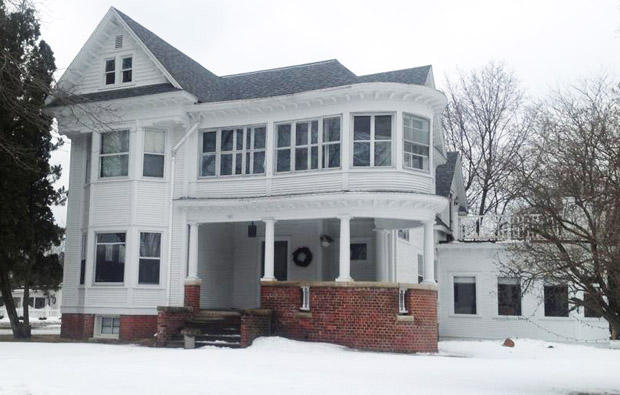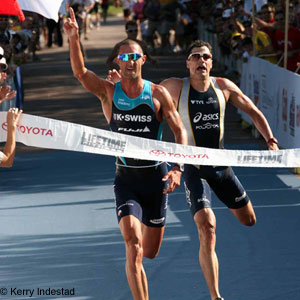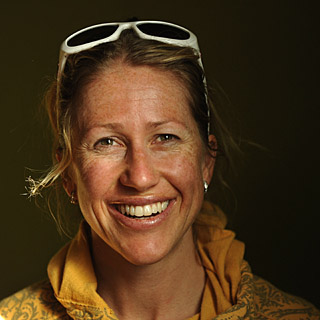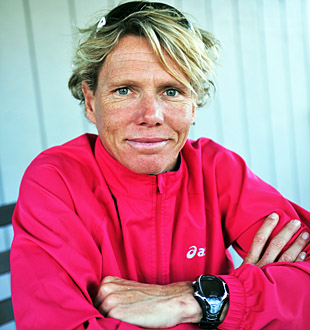Maddy Tormoen Zofingen star
In a five year period from 1990 through 1995, Maddy Tormoen was in the opinion of many observers the greatest woman duathlete in the world. She won many races in the Coors Light Duathlon Series and after that many more Powerman races. She punctuated her pro duathlon career with eight straight wins in the Powerman series and her second victory at the sport’s crown jewel at Powerman Zofingen in 1995. On that day, she collected $50,000 – the biggest prize purse in multisport to that point — $30,000 for the women’s title, $10,000 for beating all the men in a gender handicap division and another $10,000 for winning the Powerman series title.
Tormoen also qualified three times for the U.S. Olympic women’s marathon trials with a top finish of 30th place in a time of 2:41 in 1996.
Unlike other woman champions at Powerman Zofingen like Erin Baker, Paula Newby-Fraser and Natascha Badmann, Tormoen never competed in the fast-growing and more popular sport of triathlon. After spending two months trying to learn to swim competitively, she gave up and stuck to triathlon’s dry, two-discipline cousin. What few fans of the sport realized about Tormoen is that her success was somewhat of a miracle as she stoically endured dozens of operations for a myriad of leg ailments. For a competitor with a lot of courage, her greatest opponent was her own heart. Like triathlon world champions Greg Welch and Emma Carney, Tormoen has survived several near-fatal bouts of ventricular tachycardia with the aid of an implanted defibrillator.
Today, she lives in Colorado Springs and works as a counselor with the Colorado Department of Corrections.
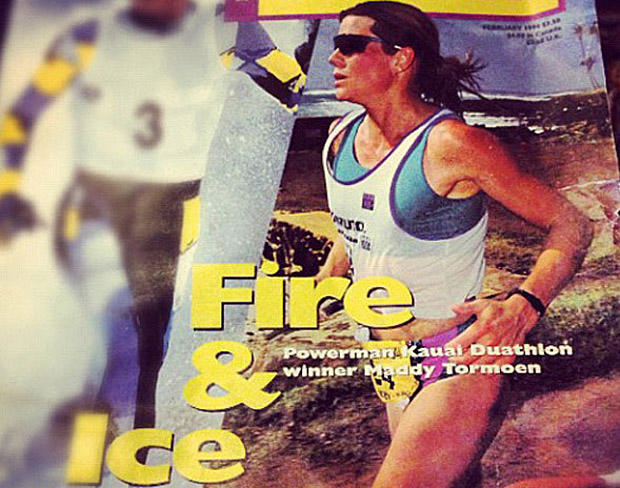
Slowtwitch: Where were you born?
Maddy Tormoen: I was born in Cook County, Illinois. We lived in Lake Bluff, just outside Chicago until I was about 3 or 4 years old.
ST: Tell us something about your parents and siblings. Any athletic inclinations?
Maddy: Neither of my parents was athletic. My mother is very artistic, and my father was a paper salesman. Both are still living, my father is living in the Minneapolis area and my mother lives near me in Colorado Springs. None of my siblings pursued athletics to the extent I did, however I had a younger sister who was a very good distance runner in high school. She also ran one year in college and with little effort qualified for nationals. One of my brothers was good at basketball.
ST: What was your family life like?
Maddy: I came from a very large and complex family. My parents divorced when I was in the 5th grade and my father eventually remarried. We started living with my father and stepmother when I was in the 7th grade, they had four more children. My father and stepmother eventually had three other foster children live with them, who were my stepmother’s sisters’ children.
ST: What is your family’s background?
Maddy: My father is mostly Norwegian, and my mother is mostly German.
ST: What traits did you inherit?
Maddy: I look very similar to my father’s mother, so I guess I have a strong Norwegian heritage. I would describe myself as fairly serious in my outlook and very determined. I am very intuitive and introverted, according to personality inventories. I am also willing to trudge along, one step at a time, to complete any task I set mind to, regardless of how long it might take. You might say I persevere in the long haul.

ST: What was your life like growing up?
Maddy: I was the fourth of six full siblings. I cried a lot as a child and did not like attending preschool. I had a neighbor boy who walked to school with me and I remember sticking my head in the bushes and crying as he tried to get me to go with him. I guess I was not so tough at that age.
ST: What sports caught your interest?
Maddy: I loved running and basketball. I was the athlete of my class; when I was young we moved to a small town in Wisconsin called Port Edwards and we lived in a large house on the Wisconsin River. There were about 60 kids in my graduating class, so we all did just about everything, we wanted to. I played the flute, acted in the school play, and engaged in three sports during the school year. My freshman year I was a bit of a troublemaker but I turned it around again during my sophomore year.
ST: Any moments growing up that defined your character?
Maddy: Well, my parents divorced when I was in the fourth grade. My mother struggled with schizophrenia during my upbringing; she was hospitalized when I was in the third grade for the first time. Then she was hospitalized again when I was in the fifth grade and a couple of times after that. Witnessing her struggle with her illness certainly impacted me, as did not having her around much of the time. For a little over a year, my siblings and I did not have any consistent adults in the home, and we supervised ourselves. This made us all very independent and we took on a parenting role for ourselves and each other at a young age. I learned pretty young about some of the cruelties life can offer, and I was therefore more serious and less light-hearted.
ST: Any early success in sport?
Maddy: I ran track and cross country in high school. I qualified for state in the 440 yard dash once, though I did not place. My PR was 60 seconds flat. I think I qualified for the state meet in cross country one year as well, though I do not remember for sure. I loved basketball and played guard and forward. I earned the nickname Stormin’ Tormoen because I was so aggressive on defense. I have a picture of me playing in high school where I look funny as I am so focused and have the eyes of a tiger.

ST: Where did you go to college?
Maddy: I attended Oregon State University initially. I was paying for my own college so I dropped out, worked, and qualified for state residency. After returning to college at OSU, I had a very bad experience in my first psychology class. Unfortunately, I signed up for what I was led to believe was a research project as part of my class requirement and the professor abused my mind. He claimed to be one of the best hypnotists in the world and was what I would describe as obsessed with shamanism and the pursuit of power, but in an evil sort of way. Unfortunately, I was young and did not understand all of this until it was too late, and he had a significant impact on me. I moved away at the end of the term and worked in San Diego before returning to school a year later in Eugene, Oregon where I earned a B.S. in psychology and M.S. in counseling psychology.
ST: Did you play college sports?
Maddy: I rowed on the eight-woman crew at OSU one fall. It was fun; I sat just behind the stroke in seat 7 so I was part of the stern pair. I had to reinforce and support the pace set by the stern. I enjoyed this seat and learned I can do well supporting someone else. I loved the team aspect.
ST: What led you to duathlon?
Maddy: While earning my master’s degree I started taking long trail runs. It was a very reflective time in my life and long runs helped me sort through the things my mind was pondering. After I graduated with my masters, I ran some local races in Eugene and I won a half marathon. I thought that was pretty good given I was in Eugene so I started to train with Mike Manley and I qualified at the Houston Marathon for the Olympic Trials. I ran the Trials but was having hamstring problems that plagued much of my career. I had my first hamstring release operation in 1989. During that time I started to bike for rehab, and after putting the two sports together I started duathlon. After a couple of races, I went to nationals and did well.
ST: What were your best running performances?
Maddy: My best results were in the marathon, but I think if I had tried to run in college I could have been a good miler and 5k runner. I actually had some untapped speed. My marathon PR was two hours, 40 minutes and 23 seconds at Cleveland in 1996 where I placed 6th on a flat and fast course. I so wanted to break 2:40 but never did.
ST: What years did you qualify for the US Olympic marathon trials?
Maddy: I qualified in 1988 in Houston with 2:43.51. Then I qualified again in 1996 at the Disneyland Marathon, and then ran 2:41:40 at the Trials where I finished 30th. I qualified for the 2004 trials at the Houston Marathon where I placed 2nd with a time of 2:45.30.
ST: You were 7th at Zofingen in 1991, 1st in 1993, 2nd in 1994, and 1st in 1995. What do you remember about your first time in Switzerland?
Maddy: That was my first time out of the country and I did not get picked up at the airport by the race committee. I was an elite athlete but no one was too worried about me at the time obviously! In the days before the race, I met some guys who took me to the basement of some building for a free meal for immigrants and I ate potatoes and gravy and green beans for lunch along with a bunch of old men who were all laughing at me. Some guy I met in an alley wanted to marry me so he could become an American citizen. I must have looked very lost walking around the city trying to figure out where I was supposed to be.
ST: What about your more successful outings at Zofingen?
Maddy: The first time I won I can hardly remember. [In 1993, Tormoen finished first in 7:14:49, 69 seconds ahead of Donna Peters, who was followed by Julieanne White, Joy Hansen and Liz Downing] In 1994, the screw that held my handlebars in place broke a few miles into the bike, so they were loose the whole 90-mile ride. Murphy Reinschreiber just about died when he saw my handlebars after the race. But it did not affect my time too much. Erin Baker would have beaten me anyhow and I ended up second [9:53 behind Baker].
ST: Tell us about your big payday at Zofingen in 1995 where you won $30,000 for first place and a $10,000 bonus for the gender handicap prize.
Maddy: In 1995, Isabelle Mouton was my main competitor. She was tough, and I knew going into the race she would push me. That year I felt a lot of pressure and had a lot riding on my shoulders. I had returned to Oregon State University to confront the professor who had been so abusive and had filed some complaints and so forth during the two years prior, so I was dealing with some difficult political issues in my personal life. But I entered the race determined to win and did. I actually earned $50,000 as I also won $10,000 for winning the Powerman series that year.

ST: Who was your coach?
Maddy: I had numerous good running coaches over the years. Joe Fulton, Mike Manley, Mike Middlestadt and Dick Brown [Mary Decker Slaney’s coach in the early ‘80s] are several I recall. I learned a lot from my running coaches that I was able to translate to training on the bike. However, I coached myself during the last two years of my racing. It worked out fine as I think this taught me to push hard at the front of a race with no one around.
ST: How many other duathlons did you win?
Maddy: Gosh, I do not know. I won every duathlon I did during the 1994-5 Powerman series. But I don’t remember all the races I won.
ST: Looking back on your racing, what gave you the most satisfaction?
Maddy: Traveling to so many places in the world and having success in sport helped me in other areas of my life. I have had to face some difficult issues and it gave me confidence to confront those things that needed addressing, and I continue to live my life in this manner. I rarely say to myself that I can’t do something I am interested in doing.
ST: Who was your greatest rival?
Maddy: Earlier in my career it was Liz Downing. Liz had dominated the sport for a long time so when I challenged her dominance it was of course considered a rivalry. When I started to focus on the Powerwoman series after the Coors Light series ended, my main rivals were often triathletes who showed up at Zofingen. At one point Heather Fuhr raced a lot of Powerwoman races. She was such a strong runner, but I was able to beat her due to my bike leg. I remember beating her in Japan; I could tell the male pros had been rooting for her. I think they just wanted to see someone else win.

ST: Describe your simple enjoyment in running?
Maddy: I love the peace and quiet of running on trails. I planned to compete in mountain races but was diagnosed with a heart ailment and had to slow down.
ST: You have had more than your share of injuries.
Maddy: Oh gosh, people did not realize how many injuries I had. I had five left knee surgeries because I hit a hurdle in high school and my leg hyper-extended, tearing out my ACL and some cartilage. I raced my entire duathlon career with no ACL in my left knee. I had three bilateral hamstring releases due to compartment syndrome; then eventually my piriformis muscle was released on both sides. Apparently that is what I needed from the start. I also had heel spurs and neuromas removed, as well as plantar fascia releases, on both feet.
ST: Why did you continue after so many operations?
Maddy: On a practical level, I simply enjoyed the process of getting back into shape after surgery. This was when I would see significant improvement and payback for my effort. On another level, I am very persistent. I think some of my experiences have given me a rare determination to succeed when it would make more sense to fail. In the past, when forced to face one of my greatest fears, it was my refusal to give up that helped me persevere. I accessed my survival instinct to the fullest because deep down I believed if I gave up, I would fall into an abyss and no one would be there to catch me. Now today, when I am challenged, this tendency has caused me to fight back excessively.
ST: What did you do after you retired from pro duathlon?
Maddy: After I retired from duathlon in 1995, I continued to run but also returned to full-time work as a counselor. I ran quite a few marathons, but also had my ACL replaced and piriformis released. In 2000 I had heart tests due to dizzy spells I experienced while training. The doctor told me I was alright but the dizzy spells recurred and got worse. In 2001 I was diagnosed with ventricular tachycardia, or VT, which is when the large chambers of the heart begin to beat too quickly, out of sync with the rest of your heart. VT is life-threatening if not terminated rather quickly.
ST: Were you surprised you suffered ventricular tachycardia after you retired?
Maddy: No. I actually had my first episode of ventricular tachycardia (VT) at the Duathlon National Championships in Santa Fe, New Mexico in 1992. I just did not know what it was at the time. I dropped out of the first run due to dizziness and blurred vision, sat down on the curb, and the symptoms went away as fast as they occurred — after about 15 seconds. I had no idea what had happened, but after I was diagnosed in 2001 I realized it had been VT that self-terminated.
ST: How many other episodes did you suffer through before diagnosis?
Maddy: In 1994 I was at O’Hare Airport in Chicago after returning from Europe with a 5-hour layover. I went out to an empty parking lot to do a few running intervals and woke up lying on the cement after my third interval. I thought I had simply fainted but in retrospect that was a bad episode of VT. I was told I was lucky to have lived; I was alone so no one witnessed exactly what occurred. I did not have any more episodes that I know of until 1998. In 2001, just after winning the Garden of the Gods 10-mile run, I went into VT that did not self-terminate. My blood pressure dropped to 30/10 that day, and I was unconscious by the time the ambulance arrived. That was when the doctors realized I needed a defibrillator.

ST: Did that solve matters?
Maddy: My first defibrillator was not a cure-all. Since I got my first, I have been shocked 32 times, 14 being inappropriate (my defibrillator shocked me when it did not need to) and 18 appropriate (the shock was to stop VT). But there is no doubt I would have died several times over if I did not have a defibrillator.
ST: How many operations have you had for VT?
Maddy: I have had a total of eight surgeries related to either implanting a defibrillator or removing old wires. I also had two ablations, a procedure that destroys a small portion of heart tissue to disrupt the electrical short-circuit in the muscle causing VT. If successful, it can drastically reduce or eliminate VT. Ablations work very well for atrial fibrillation which is when the small heart chambers beat erratically.
ST: What finally convinced you to quit competing at a professional level in running?
Maddy: I qualified for but did not run the Olympic Trials in the spring of 2004 as my ventricular tachycardia was occurring more frequently. I had an ablation for the VT at the Mayo clinic in May of 2004. Unfortunately, it made my VT worse and I got shocked a lot that summer. So that was it, there was no choice. I had another ablation in September of that year by the same doctor and was able to slowly get back into non-competitive exercise. But for the first time in my life I was too afraid to compete again as I knew I would just get shocked if I tried.
ST: What was your emotional reaction to these repeated life threatening jolts?
Maddy: I was very sad to have to stop competing. I still dream about Zofingen and duathlon, and I am 52 now. Sometimes I wake up and realize how detailed my dreams are, about how I am trying to make a comeback, and how much I just want to go and be able to compete again. I try not to think about it too much, but I miss it a lot. I was very sad it had to end the way it did; I felt broken all over again. And that was after working hard to heal from other deep wounds.
ST: Did you talk to Greg Welch about ventricular tachycardia?
Maddy: Greg and I talked a couple of times over the phone. We have both been through a lot with our hearts, and we were able to share a bit together. I let him know I would be dead without my defibrillator when he was making the decision about having one implanted. I would have enjoyed talking to him more but we all deal with our issues in our own way and I got the sense he needed space to handle his heart the way he needed to. I am really glad to hear he is doing well.
ST: Do I remember correctly that you once said you wanted to make sure that you had used up every mile in your body before you died?
Maddy: I probably did make a comment like that and I guess I’m living up to those words! I’m sure my body and mind will be entirely expired when I pass on. When I set my mind to something, I try not to leave any stone unturned. That principle helped me achieve a lot in sports and now I try to apply it to other goals. I want to have an impact on the world; I enjoy looking under the surface of things to determine what else might be going on that others are ignoring or have missed.
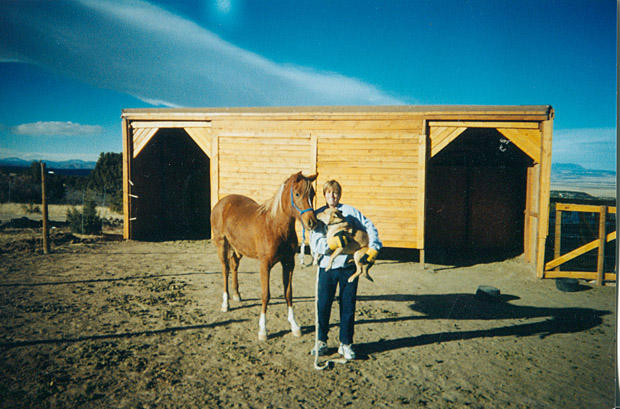
ST: What work did you pursue after you were through with sports?
Maddy: I started working full-time in the prison system in Colorado, counseling sex offenders and then inmates at the psychiatric prison. I eventually worked with incarcerated women, and then with boys committed to the Division of Youth Corrections. This is what I still do; I have always worked in the mental health arena.
ST: Describe your work.
Maddy: We have programs to help teenage boys build healthy strategies to have fun and belong, with the hope of getting them out of gang-associated criminal activity and/or substance abuse. Kids come to us with very serious addictions and criminal activity in their background. They have often experienced significant trauma and abandonment, and see little hope for a different future. I see my work as an opportunity to support youth during a difficult time in their lives, and to help them make lifestyle changes they want to make.
ST: How satisfying has it been to work as a counselor?
Maddy: It is very satisfying. I have always wanted to give back; my mother taught me to value giving through her volunteer work. By the way, she is doing great and has been stable for years. She assists boys in youth corrections by tutoring them in math and recently received an award for all her volunteer effort.
ST: What did you buy with your big $50,000 payday, the biggest in multisport at the time?
Maddy: It was a lot of money to me. I supported myself after moving out of the house at 18, so I learned to value money and understood responsibility at a young age. I bought land west of Pueblo, Colorado where I planned to build a home. Instead I built a barn and lived out there for a couple of years until I decided to move to Colorado Springs.
ST: Has your ventricular tachycardia been tamed?
Maddy: I’m doing OK. But last summer I got 12 very painful shocks that were inappropriate, meaning the shocks were unnecessary. I had the Sprint Fidelis Lead, a defibrillator wire which was recalled years ago. The Sprint Fidelis Lead breaks more frequently than other wires and when a defibrillator wire breaks it can result in the defibrillator not delivering a shock when it should, or shocking repeatedly for no reason. My Sprint Fidelis Lead broke in May of 2013 and unfortunately, the alarm did not go off to notify me of the broken wire. Medtronic developed software called the Lead Integrity Alert system for defibrillators and if programmed correctly it can warn you with an alarm that your wire is broken. My software was not programmed correctly so when my wire broke in May the alarm did not sound. Two months later the wire got so bad my defibrillator just started shocking me.
ST: What physical activity can you do now?
Maddy:I am very lucky to be able to run and ride my mountain bike at a comfortable pace. There have been times when I couldn’t, but my heart has been pretty stable for several years and my medication helps keep me out of VT. Without the medicine, I would not be able to exercise.
ST: What is the advanced degree you are pursuing now?
Maddy: I am working on my dissertation and I will graduate with a PsyD in Organizational Leadership. My focus is on iatrogenic outcomes in psychotherapy which is a fancy way of saying I am investigating the literature surrounding harmful therapeutic outcomes, exploitation and oversight within the profession. I hope to add some qualitative research to the area of study by interviewing people who have had negative counseling experiences. It is a fascinating topic and one that needs further attention, and of course my personal experiences have given me insight that many others may not have.
ST: How satisfying has it been to build that barn in Pueblo and to work on
your house and garden in Colorado Springs?
Maddy: Colorado Springs is a beautiful place to live and the downtown area is great. As for my barn, those years were very healing for me. It was an experience I will never forget and when I decided to sell my land I remember driving out there one day. It occurred to me that I was saying good-bye. I had to pull my car over to the side of the road and cry for a long time. I left a part of my soul out there; I have not returned since I sold it as I prefer to remember it as it was. I moved rocks from my land to my home here in Colorado Springs and built a rock garden in my front yard. Now I don’t know if I will ever be able to sell my home I live in now.
